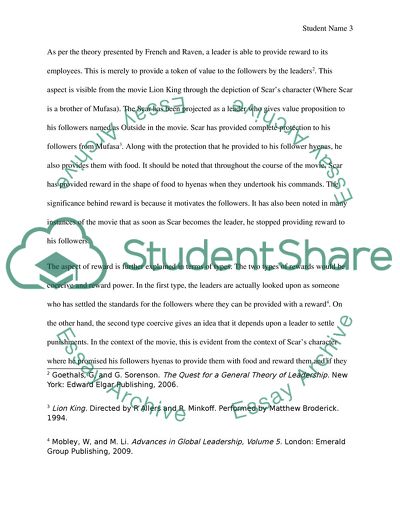Cite this document
(Leadership and Followership Stylistics: Context of Lion King Essay - 1, n.d.)
Leadership and Followership Stylistics: Context of Lion King Essay - 1. https://studentshare.org/visual-arts-film-studies/1793568-part-a-analyse-the-leadership-and-followership-styles-found-in-the-animated-film-the-lion-king-produced-by-walt-disney-in-1994-this-is-the-first-film-in-the-series-in-your-analysis-make-cross-references-to-other-topics-and-readings-from-the-unit-if
Leadership and Followership Stylistics: Context of Lion King Essay - 1. https://studentshare.org/visual-arts-film-studies/1793568-part-a-analyse-the-leadership-and-followership-styles-found-in-the-animated-film-the-lion-king-produced-by-walt-disney-in-1994-this-is-the-first-film-in-the-series-in-your-analysis-make-cross-references-to-other-topics-and-readings-from-the-unit-if
(Leadership and Followership Stylistics: Context of Lion King Essay - 1)
Leadership and Followership Stylistics: Context of Lion King Essay - 1. https://studentshare.org/visual-arts-film-studies/1793568-part-a-analyse-the-leadership-and-followership-styles-found-in-the-animated-film-the-lion-king-produced-by-walt-disney-in-1994-this-is-the-first-film-in-the-series-in-your-analysis-make-cross-references-to-other-topics-and-readings-from-the-unit-if.
Leadership and Followership Stylistics: Context of Lion King Essay - 1. https://studentshare.org/visual-arts-film-studies/1793568-part-a-analyse-the-leadership-and-followership-styles-found-in-the-animated-film-the-lion-king-produced-by-walt-disney-in-1994-this-is-the-first-film-in-the-series-in-your-analysis-make-cross-references-to-other-topics-and-readings-from-the-unit-if.
“Leadership and Followership Stylistics: Context of Lion King Essay - 1”. https://studentshare.org/visual-arts-film-studies/1793568-part-a-analyse-the-leadership-and-followership-styles-found-in-the-animated-film-the-lion-king-produced-by-walt-disney-in-1994-this-is-the-first-film-in-the-series-in-your-analysis-make-cross-references-to-other-topics-and-readings-from-the-unit-if.


